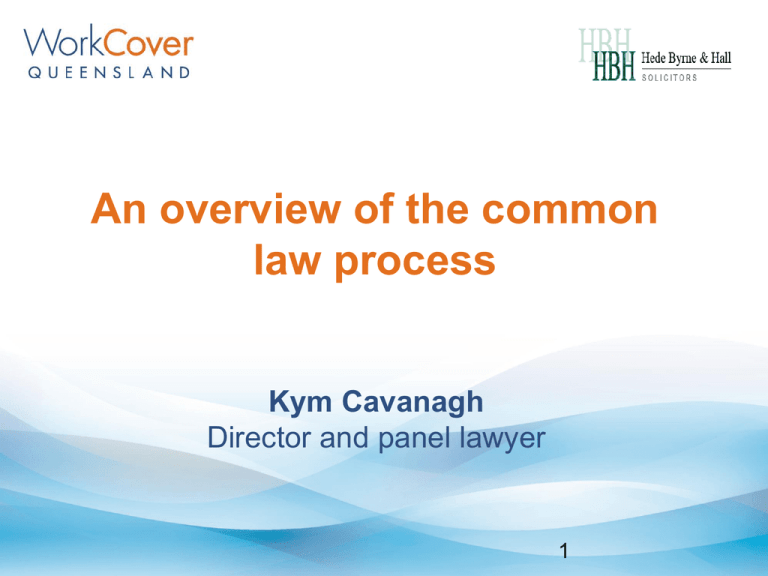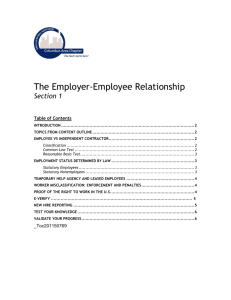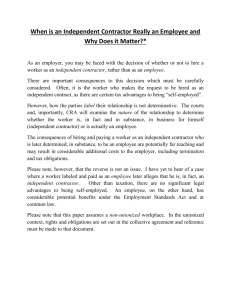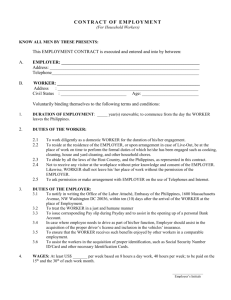An overview of the common law process
advertisement

An overview of the common law process Kym Cavanagh Director and panel lawyer 1 There must be an injury and there must be a worker An Injury is: - Personal injury - Arising out of the course of employment - Employment is a significant contributing factor Who is a worker? 2 What is the difference between a Statutory Claim and a Common Law Claim? Statutory Claim: - ‘No Fault’ - Covers Medical, Rehabilitation, weekly benefits - Focus on Return to Work Common Law Claim: - Does not always follow a Statutory Claim - Requires fault on the part of the Employer - Takes into consideration the actual loss and potential loss 3 Duty of Care An Employer owes a duty to exercise reasonable care to protect an employee against foreseeable risk of injury. An Employer’s Duty of Care is Non-Delegable An employer cannot escape liability for an injury to a worker by claiming that it delegated responsibility to another party (including an employee). 4 When can a worker pursue a Common Law claim? An injured worker must obtain a Notice of Assessment which contains an assessment of permanent impairment relating to the injury. Injuries sustained after 15 October 2013: - Physical injuries must exceed a permanent impairment of 5%; and - Employment to be the “major significant contributing factor” for psychological injuries A decision must be made – the Lump Sum Offer 5 The Start of the Common Law Claim Delivery of the “Notice of Claim” by the injured worker Indemnity provided by WorkCover Queensland Involvement of the Panel Law Firm 6 The Usual Course Notice of Claim Factual Investigations Medical Investigations Liability Response Compulsory Conference 7 What if it does not resolve at the Compulsory Conference? Mandatory Final Offers & their purpose Litigation 8 Things employers can do to minimise claims costs Pat Hall Director and panel lawyer 9 Prepare Your Business 1. Injury reporting system 2. Investigation process 3. Keep records 10 Facts are Gold and Evidence is King 1. 2. 3. 4. 5. Keep equipment or other items relevant to the incident – eg. Ladder that toppled over. Take photographs/video at the time and keep them where you can find them. If there is CCTV footage relevant to the incident – retrieve it and keep it. Identify witnesses and keep in touch with them. Obtain a really good idea of how the event occurred and document it. 11 Back to Work 1. The injured worker is not your enemy. 2. Commit to Rehabilitation. 3. Look at alternatives. 12 Contractual and insurance issues that impact claims and your business Hamish Craib Lawyer of Hede Byrne & Hall and Panel Lawyer 13 Recruitment – pre-existing injuries and medical conditions Now the WCRA has been amended to preclude claims where workers fail to disclose previous injuries or medical conditions. The employer must: Request disclosure of the pre-existing condition. Make that Request in writing. Provide information about the duties which are the subject of the proposed employment. 14 Recruitment – pre-existing injuries and medical conditions Issues: It does not provide on what basis a prospective employer can discriminate ie not hire a prospective worker who discloses the pre-existing injury or medical condition. The Courts will construe this provision narrowly. 15 Previous Claims Employers can also obtain a previous claims history from the Workers’ Compensation Regulator. The approved form can be obtained from this link: http://www.justice.qld.gov.au/__data/assets/pdf_file/0003/217317/Form-571D-Application-forclaims-history-summary.pdf 16 Recruitment – a stitch in time saves nine Do reference checks. Assess ability before hiring eg plant operation. Deal with issues when they arise eg re-training, counsel for performance issues, and if necessary terminate. 17 Contracting out of Common Law Liability It can’t be done. 18 Who is a “worker” compared to an independent contractor? Worker Directed how and when to do a certain task. Set hours for set pay. Does not supply own tools or materials. Works as directed. Cannot delegate or subcontract work to another individual or entity. Employer provides PPE. Wears a uniform. Independent Contractor Paid for an outcome eg provide and erect scaffolding. Decides when work is carried out. Provides own tools and material. Paid on completion of a job. Works for other companies. Can delegate work or subcontract. Provides own PPE. 19 Who is a “worker” compared to an independent contractor? Look at the Australian Taxation Office Employee or Contractor Tool at https://www.ato.gov.au/calculators-andtools/employee-or-contractor/. 20 Indemnity Clauses – issues for the Principal The purpose of an indemnity is to either anchor liabilities where they would otherwise lie, or to shift risk from one party to another. For example: The subcontractor indemnifies the Principal for all losses, costs and damage caused by the negligent acts or omissions of the subcontractor, its employees, agents or its subcontractors except to the extent the loss, costs and damage were caused by the negligence of the Principal. 21 Indemnity Clauses – issues for the Principal Or the Principal’s contract with the subcontractor will require an indemnity which provides: The subcontractor will indemnify the Principal for all costs, loss or damage however caused even if the costs, loss or damage are caused by any negligent act or omissions of the Principal. This indemnity is fraught with danger: The subcontractor’s WorkCover policy will not respond to any contractual risk. Most liability insurers will expressly exclude contractual risks in the policy wording. The Principal is left with no recourse but to pursue its own liability insurer. 22 Insurance Clauses The Principal must sight the Certificate of Insurance and the policy wording. Subcontractors must make sure they have all necessary insurances as required by the contract. 23 Joint and Several Liability Any finding of negligence on the part of the Principal contractor means that it must satisfy the whole of the Judgment if the subcontractor cannot pay its share due to insolvency. 24 Contribution Claims Glenda Banaghan Lawyer of Hede Byrne & Hall and Panel Lawyer 25 26 Legislation S278A of the Workers’ Compensation and Rehabilitation Act 2003 (WCRA) provides for the adding by WorkCover Queensland of another party as a contributor to a claim in the pre-proceedings stage. This is achieved by the issue of a Contribution Notice. There are time frames for these to be issued. 27 Circumstances in which a Contribution Notice would be issued Where someone else is at fault, either partially or completely, for the claimant’s injury/ies. Examples: - A faulty piece of plant/equipment manufactured/supplied by a third party; - A principal contractor; - A host employer; Eg Duong v APS Group & Ors (2010) QSC 466 30% to Employer 70% to host - A property owner/occupier Eg; Ronald v Cooks Transport & Toll unreported decision Botting DCJ 2012 85% to Toll as occupier, 15% to employer No contributory negligence as mere inadvertence. 28 29 How much will they pay Depends on the facts. Non delegable duty of care owed by Employer to Employee. 30 Contributory Negligence This refers to conduct by the Claimant which would lead to a finding that he/she acted or omitted to act in a way that contributed to their injury. 31 32 Legislation Sections 305F to 305J Same principles apply to determination of this issue as to determination of breach of duty. - Can defeat a claim (if 100%) - Presumption if intoxicated/drugs. - Not “mere inadvertence” - Bankstown Foundry v Braistina 1985-1986 160 CLR 301 Czatyrko v Edith Cowan University (2005) HCA 14 33 Examples Tabulo v Bowen Shire Council 2004 QSC 038 - Walking backwards along retaining wall sweeping aggregate, fell 2m. - 25% contribution. Contrast Daly v DA Manufacturing Co Pty Ltd & Letzbuild 2002 QSC 308 - Failure to inspect ladder prior to use, no contributory negligence. Green v Hanson Construction Materials Pty Ltd (2007) QCA 260 - 30% reduction for not using a hand rail. Sharp v Emicon 2014 NSWSC 1072 - 15% reduction for standing on the top railing of a scaffold. 34 35











